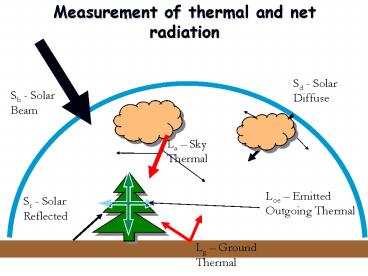Measurement of thermal and net radiation - PowerPoint PPT Presentation
1 / 20
Title:
Measurement of thermal and net radiation
Description:
Lg Ground Thermal. Loe Emitted Outgoing Thermal. Infrared Thermometer (IRT) ... If IRT sensor surface (generally blackened thermopile) has e close to 1, then ... – PowerPoint PPT presentation
Number of Views:202
Avg rating:3.0/5.0
Title: Measurement of thermal and net radiation
1
Measurement of thermal and net radiation
Sd - Solar Diffuse
Sb - Solar Beam
La Sky Thermal
Loe Emitted Outgoing Thermal
Sr - Solar Reflected
Lg Ground Thermal
2
Infrared Thermometer (IRT)
- Useful for non-contact measurement of surface T
- IRTs measure F (radiant flux density)
- If IRT sensor surface (generally blackened
thermopile) has e close to 1, then
3
Infrared Thermometer (IRT)
Ideally.
4
IRT absorption spectrum
- Most IRTs have filters that only pass 8-13 µm
radiation - Why?
Atmospheric Emittance (clear sky)
5
Measuring T with IRTs
- IRTs measure radiant flux density (F, W/m2)
- If radiating surface is not a black body, F is
made up of emitted component and reflected
component - Only emitted component affected by T
Total Fseen by IRT Femitted by surface F
emitted by surroundings and reflected
(error)
6
Errors in IRT from reflected radiation
From previous slide
What happens if Ti Ts?
7
Errors in IRT from reflected radiation
From previous slide
What happens if es 1 ?
8
Magnitude of error when e?1 and Ts ? Ti
- Generally less than 1 C under clear skies
- Much less under cloudy skies or indoors
- Correction not needed except in extreme
situations - Well create one of those situations in lab
9
Determining emissivity of a surface
Solving our favorite equation for es
So if you can measure TT, Ts, and Ti, you can
calculate es
10
Pyrgeometers
- Measure only thermal radiation
- Dome is specially designed to reflect solar and
transmit thermal radiation - Hemispherical view (unlike IRT)
11
Measurement of Total Radiation
- Total radiation solar thermal
- Now we need both wavelengths to reach sensing
surface - Still need protection from convection..
- Can we still use a glass dome?
- Can we use black and white sensor?
12
Total radiometer
solar in
thermal in
thermal emitted
conduction to base
If you assume as al e 1
C Calibration constant V mV output Need to
know Tb!
13
Measurement of Net Radiation
- Rn total incoming total outgoing total
radiation absorbed by surface - Two ways to measure
- Summation of radiation components measured
independently - Net radiometers
14
Component Summation
- Most accurate method
- Expensive several thousand for each sensor
15
Net Radiometers
- Less Expensive, Less accurate
- Measure temperature difference between upward and
downward facing surface
16
Net Radiometers
Rn Sd Ld Su - Lu
Only need to measure mV output to get Rn! (all
emissivity, absorptivity, and Tbase terms cancel
out)
17
Calibration of total and net radiometers
- Short wave calibration
- Use a known standard (Eppley or Kipp pyranometer)
- Shade simultaneously on a clear day
- Long wave altered only slightly
- Direct short wave altered equally
- From standard pyranometer you know ?Sb
- From radiometer you know ? mV
- Radiation incident on opposite side must remain
constant
Calibration ?Sb/ ? mV
18
Calibration of total and net radiometers
- Long wave calibration
- Alter long wave radiation with a long wave
emitter (radiator) - Need to know
- ? radiator temperature
- Emissivity of radiator
- Plate view factor
- Radiation incident on opposite side must remain
constant
19
Calibrating the radiometer for todays lab
?Tradiator measure with IRT or
thermocouple Emissivity radiator painted with
optical black paint, e 0.98 View Factor (F)
d distance between source and sensor L length
of the radiator edges
calibration ? F/?mV
20
Todays Lab (contd.)
- Use IRT to measure longwave energy budget for a
person - Pay attention to view factors
- Look at thermal emissivities of different surfaces































